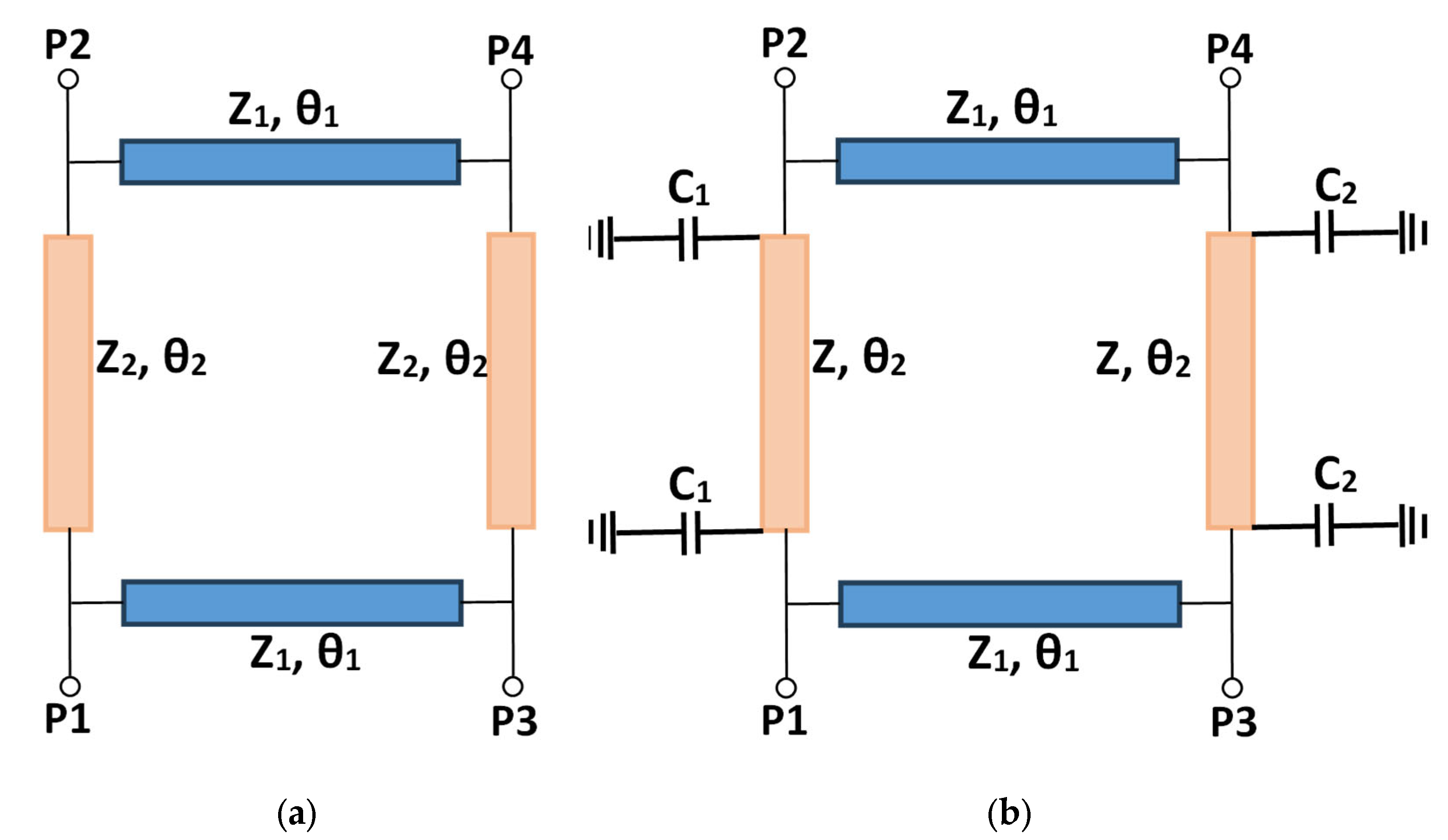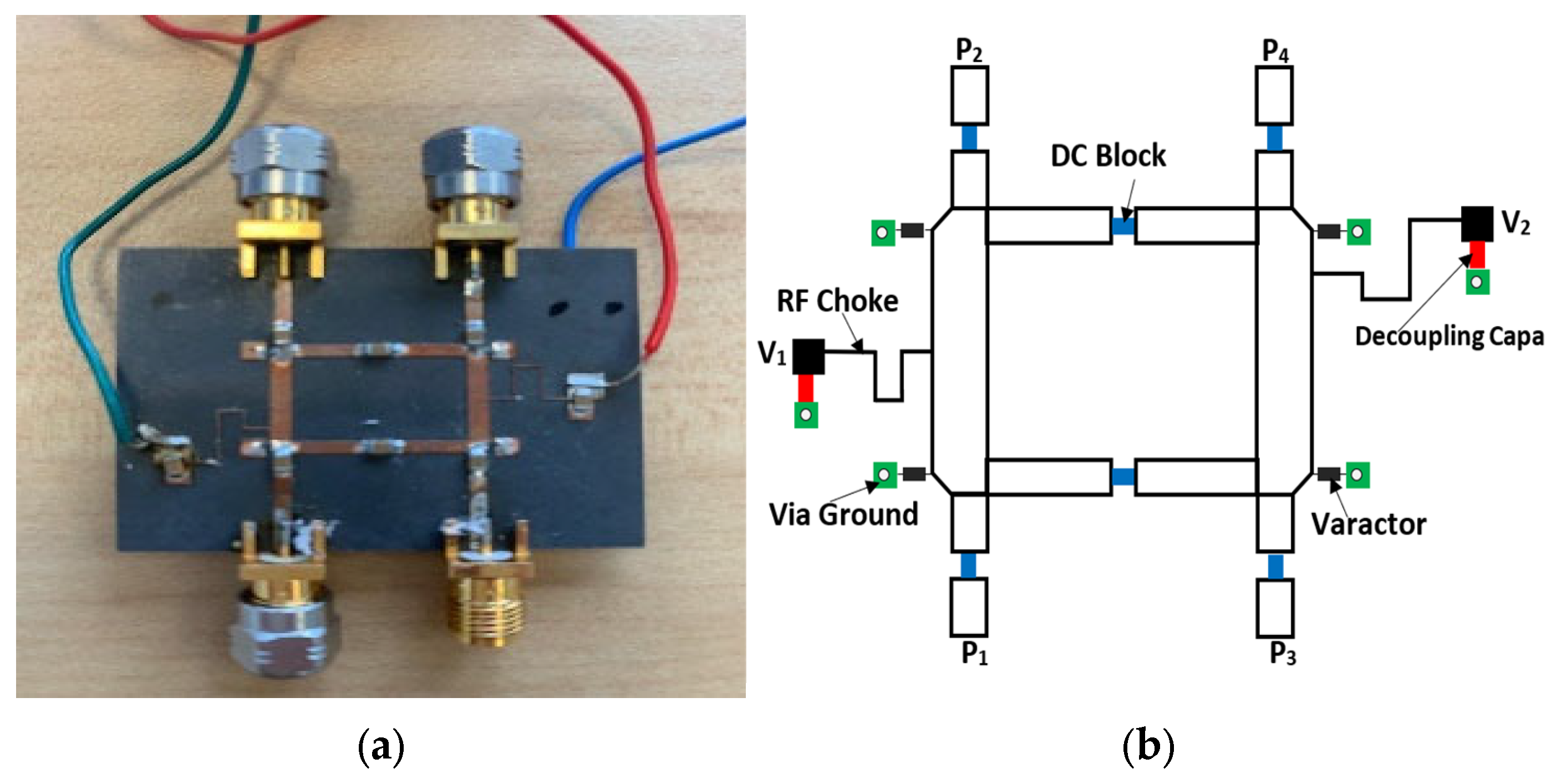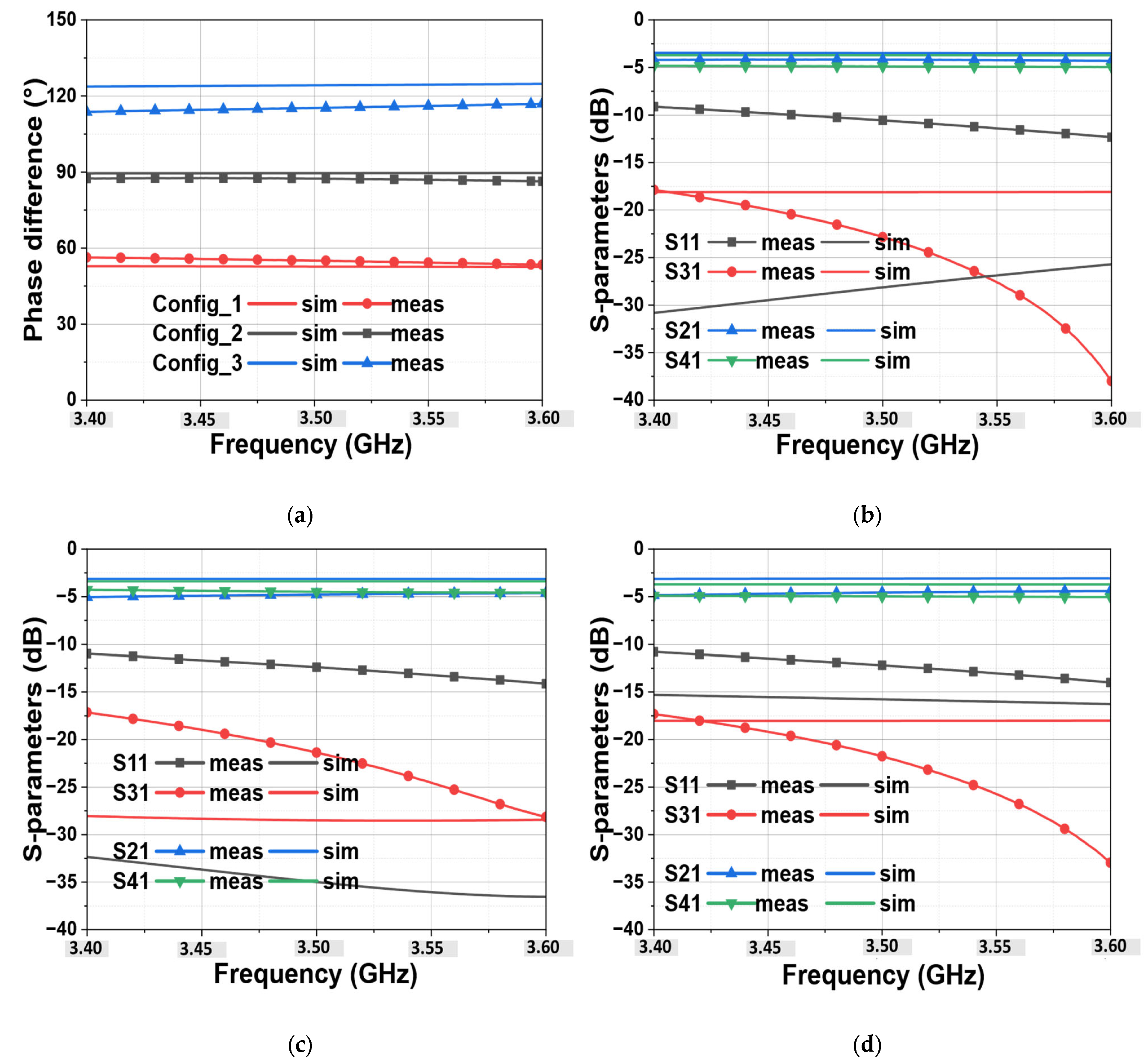Hybrid Coupler Used as Tunable Phase Shifter Based on Varactor Diodes
Abstract
:1. Introduction
2. Design and Analysis
- Analysis and calculation of the new electrical lengths θ and the new impedance Z, obtained after adding the two variable capacitors, as illustrated in Figure 1b.
- Even–odd mode analysis to obtain the parameters of the coupler taking into account θ and Z.
2.1. Analysis and Calculation of θ and Z
2.2. Even and Odd Mode Analysis of the Proposed Coupler
3. Simulation and Measurement Results
- Config_1: This configuration represents the minimum value of the phase difference, with ψ = 52°.
- Config_2: This configuration represents the conventional case, with ψ = 90°.
- Config_3: This configuration represents the maximum value of the phase difference, with ψ = 128°.
4. Conclusions
Author Contributions
Funding
Data Availability Statement
Conflicts of Interest
References
- Reed, J.; Wheeler, G. A method of analysis of Symmetrical four-port networks. IEEE Trans. Microw. Theory Tech. 1956, 4, 246–252. [Google Scholar] [CrossRef]
- Yoon, H.-J.; Min, B.-W. Two Section Wideband 90° Hybrid Coupler Using Parallel-Coupled Three-Line. IEEE Microw. Wirel. Components Lett. 2017, 27, 548–550. [Google Scholar] [CrossRef]
- Kumar, K.V.P.; Alazemi, A.J. A Flexible Miniaturized Wideband Branch-Line Coupler Using Shunt Open-Stubs and Meandering Technique. IEEE Access 2021, 9, 158241–158246. [Google Scholar] [CrossRef]
- Mocanu, I.A. Compact Dual Band Ring Coupler Using Miniaturized Metamaterial Left-Handed Impedance Inverters. IEEE Access 2021, 9, 86119–86131. [Google Scholar] [CrossRef]
- Djerafi, T.; Gauthier, J.; Wu, K. Variable coupler for Butler beam-forming matrix with low sidelobe level. IET Microwaves, Antennas Propag. 2012, 6, 1034–1039. [Google Scholar] [CrossRef]
- Xu, H.-X.; Wang, G.-M.; Wang, X. Compact Butler matrix using composite right/left handed transmission line. Electron. Lett. 2011, 47, 1081–1083. [Google Scholar] [CrossRef]
- Zheng, S.Y.; Chan, W.S.; Man, K.F. Frequency-agile patch element using varactor loaded patterned ground plane. IEEE Trans. Microw. Theory Tech. 2011, 59, 619–626. [Google Scholar] [CrossRef]
- Gurbuz, O.D.; Rebeiz, G.M. A 1.6–2.3-GHz RF MEMS reconfigurable quadrature coupler and its application to a 360∘ reflective-type phase shifter. IEEE Trans. Microw. Theory Tech. 2014, 63, 414–421. [Google Scholar] [CrossRef]
- Pan, Y.F.; Zheng, S.Y.; Pan, Y.M.; Li, Y.X.; Long, Y.L. A frequency tunable quadrature coupler with wide tuning range of center frequency and wide operating bandwidth. IEEE Trans. Circuits Syst. II Express Briefs 2017, 65, 864–868. [Google Scholar] [CrossRef]
- Ilyas, S.; Shoaib, N.; Nikolaou, S.; Cheema, H.M. A wideband tunable power divider for swipt systems. IEEE Access 2020, 8, 30675–30681. [Google Scholar] [CrossRef]
- Zheng, S.Y.; Chan, W.S.; Wong, Y.S. Reconfigurable RF quadrature patch hybrid coupler. IEEE Trans. Ind. Electron. 2012, 60, 3349–3359. [Google Scholar] [CrossRef]
- Lin, F. Compact design of planar quadrature coupler with improved phase responses and wide tunable coupling ratios. IEEE Trans. Microw. Theory Tech. 2018, 66, 1263–1272. [Google Scholar] [CrossRef]
- Liu, H.; Fang, S.; Wang, Z.; Fu, S. Design of arbitrary-phase-difference transdirectional coupler and its application to a flexible butler matrix. IEEE Trans. Microw. Theory Tech. 2019, 67, 4175–4185. [Google Scholar] [CrossRef]
- Xu, H.-X.; Wang, G.-M.; Lu, K. Microstrip Rat-Race Couplers. IEEE Microw. Mag. 2011, 12, 117–129. [Google Scholar] [CrossRef]
- Tian, G.; Yang, J.-P.; Wu, W. A novel compact Butler matrix without phase shifter. IEEE Microw. Wirel. Components Lett. 2014, 24, 306–308. [Google Scholar] [CrossRef]
- Babale, S.A.; Rahim, S.K.A.; Barro, O.A.; Himdi, M.; Khalily, M. Single Layered 4×4 Butler Matrix Without Phase-Shifters and Crossovers. IEEE Access 2018, 6, 77289–77298. [Google Scholar] [CrossRef]
- Wong, Y.S.; Zheng, S.Y.; Chan, W.S. Quasi-arbitrary phase-difference hybrid coupler. IEEE Trans. Microw. Theory Tech. 2012, 60, 1530–1539. [Google Scholar] [CrossRef]
- Park, M.-J. Comments on “Quasi-arbitrary phase-difference hybrid coupler”. IEEE Trans. Microw. Theory Tech. 2013, 61, 1397–1398. [Google Scholar] [CrossRef]
- Wu, Y.; Shen, J.; Liu, Y. Comments on “Quasi-arbitrary phase-difference hybrid coupler”. IEEE Trans. Microw. Theory Tech. 2013, 61, 1725–1727. [Google Scholar] [CrossRef]
- Ding, K.; Kishk, A. Wideband Hybrid Coupler with Electrically Switchable Phase-Difference Performance. IEEE Microw. Wirel. Components Lett. 2017, 27, 992–994. [Google Scholar] [CrossRef]
- Xu, B.; Zheng, S.; Long, Y. A phase tunable hybrid coupler with enhanced bandwidth. Int. J. RF Microw. Comput. Eng. 2019, 29, e21779. [Google Scholar] [CrossRef]
- Zhu, H.; Abbosh, A.M. A Compact Tunable Directional Coupler with Continuously Tuned Differential Phase. IEEE Microw. Wirel. Components Lett. 2018, 28, 19–21. [Google Scholar] [CrossRef]
- Matthaei, G.L.; Young, L.; Jones, E.M.T. Microwave Filters, Impedance Matching Networks and Coupling Structures; Mc Graw-Hill: New York, NY, USA, 1964. [Google Scholar]
- M/A-COM Technology Solutions Inc. (MACOM) Lowell, MA, United States: MA46580 & MA46585 Beam Lead Constant Gamma GaAs Tuning Varactor. Available online: https://cdn.macom.com/datasheets/MA46580%20and%20MA46585.pdf (accessed on 27 May 2024).
- Lambard, T.; Lafond, O.; Himdi, M.; Jeuland, H.; Bolioli, S. A novel analog 360° phase shifter design in Ku and Ka bands. Microw. Opt. Technol. Lett. 2010, 52, 1733–1736. [Google Scholar] [CrossRef]





| Parameters | Initial Values | Optimized Values after Adding the Capacitors |
|---|---|---|
| θ1 | 90° | 90° |
| θ2 | 90° | - |
| θ | - | 79° |
| Z0 | 50 Ω | 50 Ω |
| Z1 | 50 Ω | 50 Ω |
| Z2 | 35.35 Ω | - |
| Z | - | 46 Ω |
| Simulated | Measured | |||
|---|---|---|---|---|
| Biasing Voltages (V) | Capacitance (pF) | Biasing Voltages (V) | Capacitance (pF) | |
| Config_1 | V1 = 2.3 V2 = 17 | C1 = 0.8 C2 = 0.1 | V1 = 1 V2 = 18 | C1 = 1.13 C2 = 0.09 |
| Config_2 | V1 = V2 = 4.2 | C1 = C2 = 0.53 | V1 = V2 = 4.2 | C1 = C2 = 0.53 |
| Config_3 | V1 = 17 V2 = 2.3 | C1 = 0.1 C2 = 0.8 | V1 = 18 V2 = 1 | C1 = 0.09 C2= 1.13 |
| Biasing DC Points | Biasing Voltages (V) | |
|---|---|---|
| Simulated | Measured | |
| 1 | V1 = 2.3; V2 = 17 | V1 = 1; V2 = 18 |
| 2 | V1 = 2.5; V2 = 13 | V1 = 1.5; V2 = 16 |
| 3 | V1 = 2.7; V2 = 9 | V1 = 2; V2 = 14 |
| 4 | V1 = 2.9; V2 = 8 | V1 = 2.3; V2 = 12 |
| 5 | V1 = 3.1; V2 = 7 | V1 = 2.7; V2 = 9 |
| 6 | V1 = 3.5; V2 = 6 | V1 = 3.3; V2 = 8 |
| 7 | V1 = 3.9; V2 = 5 | V1 = 3.8; V2 = 6 |
| 8 | V1 = 4.2; V2 = 4.2 | V1 = 4.2; V2 = 4.2 |
| 9 | V1 = 4.6; V2 = 3.7 | V1 = 6; V2 = 3.8 |
| 10 | V1 = 7.5; V2 = 3 | V1 = 9; V2 = 2.7 |
| 11 | V1 = 17; V2 = 2.3 | V1 = 18; V2 = 1 |
Disclaimer/Publisher’s Note: The statements, opinions and data contained in all publications are solely those of the individual author(s) and contributor(s) and not of MDPI and/or the editor(s). MDPI and/or the editor(s) disclaim responsibility for any injury to people or property resulting from any ideas, methods, instructions or products referred to in the content. |
© 2024 by the authors. Licensee MDPI, Basel, Switzerland. This article is an open access article distributed under the terms and conditions of the Creative Commons Attribution (CC BY) license (https://creativecommons.org/licenses/by/4.0/).
Share and Cite
Benaouf, T.M.; Hamdoun, A.; Himdi, M.; Lafond, O.; Ammor, H. Hybrid Coupler Used as Tunable Phase Shifter Based on Varactor Diodes. Micromachines 2024, 15, 838. https://doi.org/10.3390/mi15070838
Benaouf TM, Hamdoun A, Himdi M, Lafond O, Ammor H. Hybrid Coupler Used as Tunable Phase Shifter Based on Varactor Diodes. Micromachines. 2024; 15(7):838. https://doi.org/10.3390/mi15070838
Chicago/Turabian StyleBenaouf, Taleb Mohamed, Abdelaziz Hamdoun, Mohamed Himdi, Olivier Lafond, and Hassan Ammor. 2024. "Hybrid Coupler Used as Tunable Phase Shifter Based on Varactor Diodes" Micromachines 15, no. 7: 838. https://doi.org/10.3390/mi15070838
APA StyleBenaouf, T. M., Hamdoun, A., Himdi, M., Lafond, O., & Ammor, H. (2024). Hybrid Coupler Used as Tunable Phase Shifter Based on Varactor Diodes. Micromachines, 15(7), 838. https://doi.org/10.3390/mi15070838








